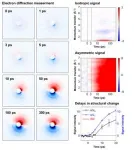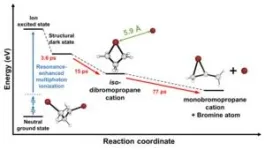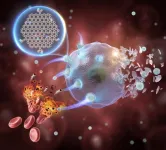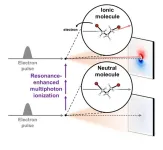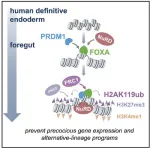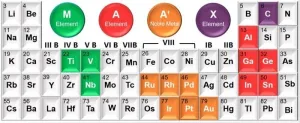(Press-News.org) Researchers have created the world’s largest ancient human gene bank by analysing the bones and teeth of almost 5,000 humans who lived across western Europe and Asia up to 34,000 years ago.
By sequencing ancient human DNA and comparing it to modern-day samples, the international team of experts mapped the historical spread of genes – and diseases – over time as populations migrated.
The ‘astounding’ results have been revealed in four trailblazing research papers published today (10 January 2024) in the same issue of Nature and provide new biological understanding of debilitating disorders.
The extraordinary study involved a large international team led by Professor Eske Willerslev at the Universities of Cambridge and Copenhagen, Professor Thomas Werge at the University of Copenhagen, and Professor Rasmus Nielsen at University of California, Berkeley and involved contributions from 175 researchers from around the globe.
The scientists found:
The startling origins of neurodegenerative diseases including multiple sclerosis
Why northern Europeans today are taller than people from southern Europe
How major migration around 5,000 years ago introduced risk genes into the population in north-western Europe – leaving a legacy of higher rates of MS today
Carrying the MS gene was an advantage at the time as it protected ancient farmers from catching infectious diseases from their sheep and cattle
Genes known to increase the risk of diseases such as Alzheimer’s and type 2 diabetes were traced back to hunter gatherers
Future analysis is hoped to reveal more about the genetic markers of autism, ADHD, schizophrenia, bipolar disorder, and depression
Northern Europe has the highest prevalence of multiple sclerosis in the world. A new study has found the genes that significantly increase a person’s risk of developing multiple sclerosis (MS) were introduced into north-western Europe around 5,000 years ago by sheep and cattle herders migrating from the east.
By analysing the DNA of ancient human bones and teeth, found at documented locations across Eurasia, researchers traced the geographical spread of MS from its origins on the Pontic Steppe (a region spanning parts of what are now Ukraine, South-West Russia and the West Kazakhstan Region).
They found that the genetic variants associated with a risk of developing MS ‘travelled’ with the Yamnaya people - livestock herders who migrated over the Pontic Steppe into North-Western Europe.
These genetic variants provided a survival advantage to the Yamnaya people, most likely by protecting them from catching infections from their sheep and cattle. But they also increased the risk of developing MS.
“It must have been a distinct advantage for the Yamnaya people to carry the MS risk genes, even after arriving in Europe, despite the fact that these genes undeniably increased their risk of developing MS,” said Professor Eske Willerslev, jointly at the Universities of Cambridge and Copenhagen and a Fellow of St John’s College, an expert in analysis of ancient DNA and Director of the project.
He added: “These results change our view of the causes of multiple sclerosis and have implications for the way it is treated.”
The age of specimens ranges from the Mesolithic and Neolithic through the Bronze Age, Iron Age and Viking period into the Middle Ages. The oldest genome in the data set is from an individual who lived approximately 34,000 years ago.
The findings provide an explanation for the ‘North-South Gradient’, in which there are around twice as many modern-day cases of MS in northern Europe than southern Europe, which has long been a mystery to researchers.
From a genetic perspective, the Yamnaya people are thought to be the ancestors of the present-day inhabitants of much of North-Western Europe. Their genetic influence on today’s population of southern Europe is much weaker.
Previous studies have identified 233 genetic variants that increase the risk of developing MS. These variants, also affected by environmental and lifestyle factors, increase disease risk by around 30 percent. The new research found that this modern-day genetic risk profile for MS is also present in bones and teeth that are thousands of years old.
“These results astounded us all. They provide a huge leap forward in our understanding of the evolution of MS and other autoimmune diseases. Showing how the lifestyles of our ancestors impacted modern disease risk just highlights how much we are the recipients of ancient immune systems in a modern world,” said Dr William Barrie, a postdoc in the University of Cambridge’s Department of Zoology and co-author of the paper.
Multiple sclerosis is a neurodegenerative disease in which the body’s immune system mistakenly attacks the ‘insulation’ surrounding the nerve fibres of the brain and spinal cord. This causes symptom flares known as relapses as well as longer-term degeneration, known as progression.
Professor Lars Fugger, a co-author of the MS study professor and consultant physician at John Radcliffe Hospital, University of Oxford, said: “This means we can now understand and seek to treat MS for what it actually is: the result of a genetic adaptation to certain environmental conditions that occurred back in our prehistory.”
Professor Astrid Iversen, another co-author based at the University of Oxford, said: “We now lead very different lives to those of our ancestors in terms of hygiene, diet, and medical treatment options and this combined with our evolutionary history means we may be more susceptible to certain diseases than our ancestors were, including autoimmune diseases such as MS.”
The Lundbeck Foundation GeoGenetics Centre – the resource underpinning the discoveries
The new findings were made possible by the analysis of data held in a unique gene bank of ancient DNA, created by the researchers over the past five years with funding from the Lundbeck Foundation.
This is the first gene bank of its kind in the world and already it has enabled fascinating new insights in areas from ancient human migrations, to genetically-determined risk profiles for the development of brain disorders.
By analysing the bones and teeth of almost 5,000 ancient humans, held in museum collections across Europe and Western Asia, the researchers generated DNA profiles ranging across the Mesolithic and Neolithic through the Bronze Age, Iron Age and Viking period into the Middle Ages. They compared the ancient DNA data to modern DNA from 400,000 people living in Britain, held in the UK Biobank.
“Creating a gene bank of ancient DNA from Eurasia’s past human inhabitants was a colossal project, involving collaboration with museums across the region,” said Willerslev.
He added: “We’ve demonstrated that our gene bank works as a precision tool that can give us new insights into human diseases, when combined with analyses of present-day human DNA data and inputs from several other research fields. That in itself is amazing, and there’s no doubt it has many applications beyond MS research.”
The team now plans to investigate other neurological conditions including Parkinson’s and Alzheimer’s diseases, and psychiatric disorders including ADHD and schizophrenia.
They have received requests from disease researchers across the world for access to the ancient DNA profiles, and eventually aim to make the gene bank open access.
The research was funded by a €8M grant from the Lundbeck Foundation, and conducted at the Lundbeck Foundation Geogenetics Centre at the University of Copenhagen.
Jan Egebjerg, Director of Research at the Lundbeck Foundation, said: "The rationale for awarding such a large research grant to this project, as the Lundbeck Foundation did back in 2018, was that if it all worked out, it would represent a trail-blazing means of gaining a deeper understanding of how the genetic architecture underlying brain disorders evolved over time. And brain disorders are our specific focus area."
END
Ancient DNA reveals reason for high multiple sclerosis and Alzheimer’s rates in Europe
2024-01-10
ELSE PRESS RELEASES FROM THIS DATE:
Noninvasive test for embryo quality could streamline fertility treatment
2024-01-10
In-vitro-fertilization (IVF), a fertility treatment that involves fertilizing eggs in the laboratory and later implanting them in the uterus, has been a source of hope for many people struggling to conceive. However, the multi-step process is complex, and the overall live birth rate after IVF treatment is only 20-40% in females younger than 40 in the United States. One of the reasons for this low success rate is that it’s very difficult for doctors to determine which lab-grown embryos are most likely to result in a successful pregnancy, so many people seeking IVF must go through multiple rounds of treatment.
Now, scientists at University of California San Diego School of ...
Metal-free graphene quantum dots show promise for highly efficient tumor therapy
2024-01-10
A research group led by Prof. WANG Hui from the Hefei Institutes of Physical Science (HFIPS) of the Chinese Academy of Sciences has introduced a metal-free nanozyme based on graphene quantum dots (GQDs) for highly efficient tumor chemodynamic therapy (CDT).
The study was published in Matter.
GQDs represent a promising and cost-effective means of addressing the toxicity concerns associated with metal-based nanozymes in tumor CDT. However, the limited catalytic activity of GQDs has posed significant challenges for their clinical application, particularly under challenging catalytic conditions.
"The obtained GQDs, which are made from red blood cell membranes, ...
Scientists name the commonest tropical tree species for the first time
2024-01-10
UCL Press Release + table
Under embargo until Wednesday 10 January 2024, 16:00 UK time / 11:00 US Eastern time
A major international collaboration of 356 scientists led by UCL researchers has found almost identical patterns of tree diversity across the world’s tropical forests.
The study of over one million trees across 1,568 locations, published in Nature, found that just 2.2% of tree species make up 50% of the total number of trees in tropical forests across Africa, the Amazon, and Southeast Asia. Each continent consists of the same proportion of a few common species and many rare species.
While ...
Global prevalence of adolescent use of nonprescription weight-loss products
2024-01-10
About The Study: This meta-analysis that included 90 studies with 604,000 participants found that use of weight-loss products occurs at high levels in adolescents, especially girls. These findings suggest that, given the ineffectiveness of these products for weight loss coupled with their harmful long-term health consequences, interventions are required to reduce use of weight-loss products in this group.
Authors: Natasha Yvonne Hall, Pharm.B., M.H.E., of Deakin University in Melbourne, Australia, is the corresponding author.
To access the embargoed study: Visit our For ...
Early prediction of autistic spectrum disorder using developmental surveillance data
2024-01-10
About The Study: In this study of nearly 1.2 million children, prediction models achieved high performance in predicting the likelihood of autistic spectrum disorder, using information from routine developmental assessments. This tool may be seamlessly integrated in the clinical workflow to improve early identification of children who may benefit from timely interventions.
Authors: Guy Amit, Ph.D., of the KI Research Institute in Kfar Malal, Israel, is the corresponding author.
To access the embargoed study: Visit our For The Media website at this link https://media.jamanetwork.com/
(doi:10.1001/jamanetworkopen.2023.51052)
Editor’s ...
Epic of a molecular ion: With eyes of electrons
2024-01-10
Ions are everywhere, from our daily surroundings to the cosmic expanse. As common table salt (NaCl) dissolves into sodium (Na+) and chloride (Cl-) ions in water, it imparts a salty taste. Once absorbed by the body, these ions regulate nerve impulses and muscle movements. In the sun, plasma—a gathering of ions in the gaseous state—undergoes nuclear fusion reactions, transmitting light and energy to Earth. One of the most noteworthy usage ions in everyday life is found in lithium-ion batteries, ...
Scientists find “key” to potential breast cancer prevention, treatment
2024-01-10
CHAPEL HILL, N.C. – Every time a cancer cell divides, it sustains damage to its own DNA molecules. Researchers, including Gaorav Gupta, MD, PhD, associate professor in the Department of Radiation Oncology at the UNC School of Medicine, have long wondered how cancers are able to evade detection by the body’s own defenses, despite the immune system being on constant watch for cells displaying DNA damage.
New findings by Gupta’s lab, which were published in Nature, shows how the cGAS-STING pathway – a pathway inside cells essential for activating the inflammatory immune response – is unleashed to prevent cancer formation by detecting DNA damage within ...
Almost 1:10 adolescents non-prescription weight loss products globally
2024-01-10
One in ten adolescents globally have used ineffective and potentially harmful non prescribed weight loss products in their lifetime, with 2% using them in the previous week.
A review, of over 90 studies of 600,000+ participants, headed by Ms Natasha Hall fro0m Monash University's School of Public Health and Preventive Medicine and published in the Journal of the American Medical Association has found that adolescent use of non prescription weight loss products is 5.5% overall, 2% in the past week; 4.4% in the past month, 6.2% in the past year and 8.9% in their lifetime.
The authors caution against the long term consequences of these ineffective treatments. END ...
How ‘pioneers’ blaze the one trail that determines cell fate
2024-01-10
One of the important breakthroughs that made it possible to program or reprogram cell fate more efficiently and with higher fidelity in a dish was discovering how to make use of a small set of molecular cowboys called pioneer transcription factors (TFs).
Every cell in our bodies has more than 200 transcription factors expressed inside, riding along the DNA helix instructing specific genes to activate and deactivate. During the early stages of fetal development, a small subset of “pioneer” TFs act inside ...
General A-site alloying strategy helps to prepare noble metal-occupied MAX phases
2024-01-10
Researchers led by Prof. HUANG Qing from the Ningbo Institute of Materials Technology and Engineering (NIMTE) of the Chinese Academy of Sciences, in collaboration with researchers from the Zhejiang Institute of Tianjin University, and Linköping University, Sweden, has proposed a general A-site alloying strategy for the preparation of noble metal-occupied MAX phases.
This work was published in Matter.
MAX phases are a family of ternary layered transition metal carbides that have attracted great attention ...

